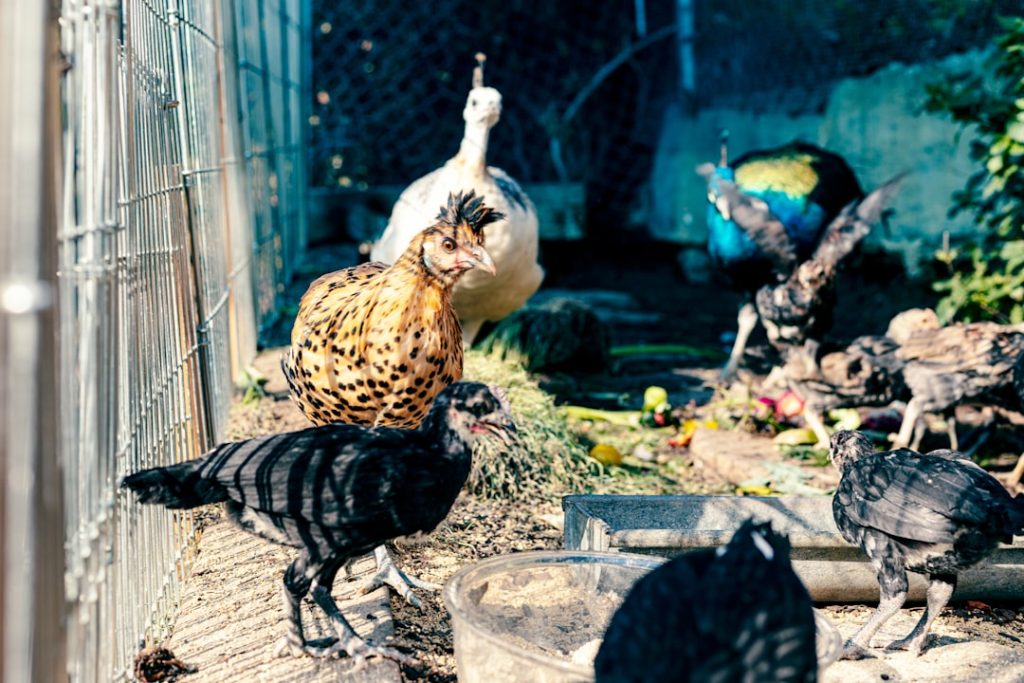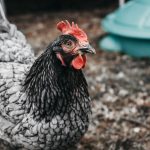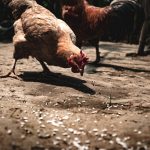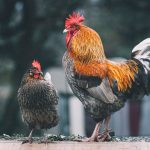Chickens and cockerels are domesticated fowl with distinct characteristics. Chickens are female, while cockerels are male. Cockerels are typically larger, more colorful, and have more prominent combs, wattles, and tail feathers than chickens.
They are known for their loud crowing, used to mark territory and attract mates. Chickens are generally quieter and focus on nesting and egg care. In reproduction, cockerels fertilize the eggs laid by chickens.
Within a flock, chickens lay eggs while cockerels protect the group and mate with hens. This division of roles contributes to the flock’s overall health and productivity. Understanding these differences is crucial for proper flock management.
For instance, introducing a new cockerel to an established flock can cause aggression as the birds establish their hierarchy. Knowledge of these distinctions helps flock owners create a harmonious environment and prevent potential conflicts among the birds.
Table of Contents
- 1 Creating a suitable living environment for chickens and cockerels
- 2 Managing the pecking order within the flock
- 3 Providing appropriate nutrition for both chickens and cockerels
- 4 Addressing potential aggression and conflicts within the flock
- 5 Recognizing the signs of illness and disease in chickens and cockerels
- 6 Ensuring the safety and well-being of chickens and cockerels in the coop and yard
- 7 FAQs
Key Takeaways
- Chickens are female, while cockerels are male, and they have distinct physical and behavioral differences.
- A suitable living environment for chickens and cockerels includes a secure coop, nesting boxes, roosting bars, and access to a run or yard.
- Managing the pecking order within the flock involves providing enough space, food, and water, and monitoring for signs of aggression.
- Appropriate nutrition for chickens and cockerels includes a balanced diet of layer feed for hens and grower feed for roosters, supplemented with fresh fruits and vegetables.
- Addressing potential aggression and conflicts within the flock requires observing and separating aggressive birds, providing distractions, and ensuring enough space and resources for all birds.
Creating a suitable living environment for chickens and cockerels
The Coop: A Safe and Comfortable Space
The coop should provide ample space for the birds to move around and roost comfortably. It should also be well-ventilated to prevent the buildup of ammonia from droppings, which can lead to respiratory issues. Additionally, the coop should be predator-proof to protect the birds from potential threats such as foxes, raccoons, and birds of prey. Providing nesting boxes for the chickens to lay their eggs is also important, as it gives them a safe and comfortable space to do so.
The Outdoor Run or Yard: A Space for Natural Behavior
In addition to the coop, chickens and cockerels also need access to an outdoor run or yard where they can forage for insects and plants. This not only provides them with essential nutrients but also allows them to engage in natural behaviors such as scratching and dust bathing. The outdoor area should be fenced to prevent the birds from wandering off and to protect them from predators.
Enrichment and Stimulation: Keeping the Birds Active and Engaged
Providing perches and enrichment activities such as hanging treats or toys can also help keep the birds mentally stimulated and physically active. This is an important aspect of creating a suitable living environment for chickens and cockerels, as it helps to prevent boredom and stress.
Overall, creating a suitable living environment for chickens and cockerels involves careful consideration of their physical and behavioral needs, as well as protection from potential threats.
Managing the pecking order within the flock
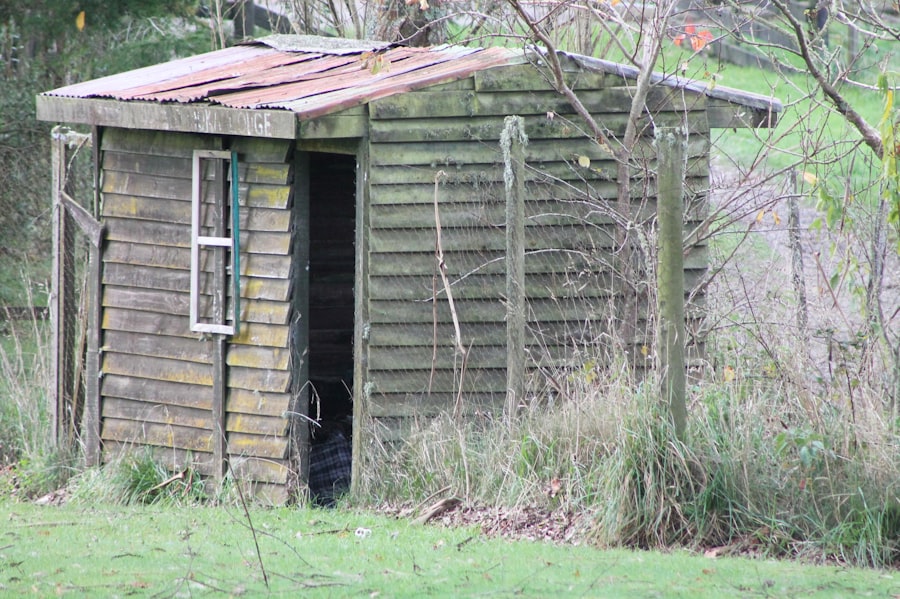
The pecking order is a natural social hierarchy that exists within a flock of chickens and cockerels. It determines the ranking of each bird within the group and influences their access to resources such as food, water, and nesting sites. Understanding and managing the pecking order is important for maintaining harmony within the flock and preventing aggression and conflicts.
One way to manage the pecking order is by providing multiple feeding and watering stations to prevent dominant birds from monopolizing these resources. This ensures that all members of the flock have equal access to essential nutrients and hydration. Another way to manage the pecking order is by introducing new birds to the flock carefully.
This can disrupt the existing hierarchy and lead to aggression as the birds establish a new pecking order. To minimize conflicts, it’s important to introduce new birds gradually and in a neutral territory. This gives them time to establish their place within the flock without being overwhelmed by existing members.
Additionally, providing ample space within the coop and outdoor run can help reduce competition among birds and minimize aggressive behaviors. By managing the pecking order within the flock, flock owners can create a more peaceful and harmonious living environment for their chickens and cockerels.
Providing appropriate nutrition for both chickens and cockerels
Providing appropriate nutrition is essential for the health and well-being of chickens and cockerels. A balanced diet should include a mix of grains, seeds, fruits, vegetables, and protein sources such as insects or mealworms. Chickens also require calcium to produce strong eggshells, so providing access to oyster shells or crushed eggshells is important for laying hens.
Cockerels, on the other hand, may require a higher protein diet to support their larger size and muscle development. It’s important to provide access to fresh water at all times, as dehydration can lead to health issues such as reduced egg production or heat stress. In addition to a balanced diet, providing appropriate nutrition also involves monitoring the body condition of the birds.
Overweight or underweight birds may require adjustments to their diet to maintain a healthy weight. Additionally, providing access to grit or small stones is important for chickens and cockerels, as it helps them grind their food in their gizzards for digestion. Overall, providing appropriate nutrition for both chickens and cockerels involves careful consideration of their dietary needs at different life stages, as well as monitoring their body condition to ensure they are receiving adequate nutrition.
Addressing potential aggression and conflicts within the flock
Aggression and conflicts within a flock of chickens and cockerels can arise due to various reasons such as establishing a pecking order, mating behavior, or resource competition. Addressing potential aggression and conflicts involves understanding the underlying causes and taking steps to minimize stress and aggression among the birds. One way to address aggression is by providing ample space within the coop and outdoor run to reduce competition for resources such as food, water, and nesting sites.
This can help minimize aggressive behaviors such as pecking or bullying. Another way to address potential aggression is by providing enrichment activities such as hanging treats or toys to keep the birds mentally stimulated and physically active. Boredom can lead to aggressive behaviors, so providing opportunities for natural behaviors such as scratching, dust bathing, or foraging can help reduce stress and aggression within the flock.
Additionally, monitoring the birds for signs of injury or stress can help identify potential conflicts early on and take steps to address them before they escalate. By addressing potential aggression and conflicts within the flock, flock owners can create a more peaceful living environment for their chickens and cockerels.
Recognizing the signs of illness and disease in chickens and cockerels

Common Signs of Illness
Common signs of illness include lethargy, decreased appetite, abnormal droppings, respiratory issues such as coughing or sneezing, abnormal posture or movement, or changes in comb color or wattles. Additionally, changes in behavior such as increased aggression or isolation from the flock can also indicate underlying health issues.
Monitoring and Prevention
It’s essential for flock owners to monitor their birds regularly for any changes in behavior or physical appearance that may indicate illness. In addition to recognizing signs of illness, preventing disease through biosecurity measures is also important for maintaining the health of chickens and cockerels. This includes quarantining new birds before introducing them to an existing flock, practicing good hygiene by regularly cleaning the coop and equipment, and preventing contact with wild birds or other potential carriers of disease.
Supporting Immune Health
Providing access to clean water and a balanced diet also supports the immune system of chickens and cockerels, helping them resist potential infections or diseases. By recognizing the signs of illness and disease early on and implementing preventive measures, flock owners can ensure the health and well-being of their chickens and cockerels.
Ensuring the safety and well-being of chickens and cockerels in the coop and yard
Ensuring the safety and well-being of chickens and cockerels in the coop and yard involves taking steps to protect them from potential threats such as predators, extreme weather conditions, or accidents. Predator-proofing the coop by using sturdy fencing, secure latches on doors, and covering windows with hardware cloth can help prevent attacks from predators such as foxes, raccoons, or birds of prey. Additionally, providing a secure outdoor run with a roof or netting can protect the birds from aerial predators such as hawks or owls.
In addition to predator-proofing, ensuring the safety of chickens and cockerels also involves protecting them from extreme weather conditions such as heat stress or cold temperatures. Providing shade in the outdoor run during hot weather, ensuring access to fresh water at all times, and insulating the coop during cold weather can help protect the birds from weather-related health issues. Regularly inspecting the coop and outdoor run for potential hazards such as sharp objects or tripping hazards can also help prevent accidents that may injure the birds.
By ensuring the safety and well-being of chickens and cockerels in the coop and yard, flock owners can create a secure living environment that promotes their health and happiness. In conclusion, understanding the differences between chickens and cockerels is essential for managing their care effectively. Creating a suitable living environment involves providing ample space, protection from predators, access to natural behaviors such as foraging, scratching, and dust bathing, as well as mental stimulation through enrichment activities.
Managing the pecking order within the flock involves providing multiple feeding stations, introducing new birds carefully, and providing ample space to reduce competition among birds. Providing appropriate nutrition includes offering a balanced diet tailored to their specific needs at different life stages while monitoring their body condition regularly. Addressing potential aggression involves providing ample space, enrichment activities, monitoring for signs of stress or injury, while recognizing signs of illness involves monitoring their behavior regularly while implementing preventive measures through biosecurity practices.
Ensuring safety involves predator-proofing coops, protecting them from extreme weather conditions while preventing accidents through regular inspections of potential hazards in their living environment. By understanding these aspects of care for chickens and cockerels, flock owners can create a harmonious living environment that promotes their health and well-being.
If you’re considering keeping chickens and cockerels together, it’s important to provide them with a suitable coop. According to Poultry Wizard, the type of coop you choose can greatly impact the well-being of your birds. In their article on “What kind of coop is best for chickens,” they discuss the different options available and the factors to consider when selecting the right coop for your flock. (source)
FAQs
Can chickens and cockerels live together?
Yes, chickens and cockerels can live together in the same flock. However, it’s important to monitor their behavior and ensure that there is enough space and resources for both.
Do chickens and cockerels get along?
In general, chickens and cockerels can get along well if they are raised together from a young age. However, there may be some aggression between them, especially during mating season.
What should I consider when keeping chickens and cockerels together?
When keeping chickens and cockerels together, it’s important to provide enough space, nesting boxes, and food and water sources to prevent competition and aggression. Additionally, it’s important to monitor their behavior and separate any aggressive individuals if necessary.
Can cockerels be aggressive towards chickens?
Cockerels can be aggressive towards chickens, especially during mating season. It’s important to monitor their behavior and separate any aggressive individuals to prevent injuries to the hens.
How many hens should I have per cockerel?
A general rule of thumb is to have about 8-10 hens per cockerel to prevent over-mating and aggression. However, this ratio may vary depending on the individual personalities of the birds.
Meet Walter, the feathered-friend fanatic of Florida! Nestled in the sunshine state, Walter struts through life with his feathered companions, clucking his way to happiness. With a coop that’s fancier than a five-star hotel, he’s the Don Juan of the chicken world. When he’s not teaching his hens to do the cha-cha, you’ll find him in a heated debate with his prized rooster, Sir Clucks-a-Lot. Walter’s poultry passion is no yolk; he’s the sunny-side-up guy you never knew you needed in your flock of friends!

